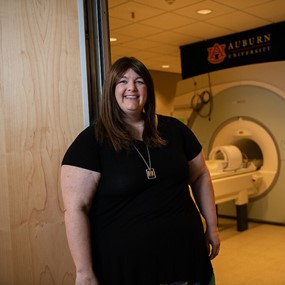Food historian comments on wet markets and COVID-19

There has been a lot of speculation and misinformation about what wet markets are since the COVID-19 outbreak. We asked Xaq Frohlich, assistant professor of history, whose research focuses on the historical intersections of science, law and markets, and how the three have shaped our modern everyday understanding of food, risk and responsibility, to share his expert knowledge with us to separate fact from fiction.
Frohlich earned his PhD in history, anthropology, and STS at MIT in 2011 and has been on the faculty at Auburn since 2017. He is currently completing a book manuscript, From Label to Table: Regulating Food in the Information Age, which explores the history of efforts by the U.S. Food and Drug Administration (FDA) to manage food markets through the regulation of food labels in the second half of the twentieth century.
1. Why are people suddenly talking about “wet markets” in Asia? And how are they related to the COVID-19 or Coronavirus pandemic?
The current media interest in wet markets in Asia is because a wet market, the Huanan Seafood Wholesale Market in Wuhan, China, is suspected of being the source of the COVID-19 outbreak. The key word here is suspected. This is because 27 people out of the initial cluster of 41 cases of coronavirus in Wuhan, where the disease first appeared, had visited that market. On the other hand, the first reported hospital case in Wuhan was a person who had never been there. So, there are other plausible explanations for what might have caused the outbreak, including the city’s expansion into forest areas nearby, where there are wild bat populations, and even one report that suggests the initial outbreak might be linked to a scientific laboratory in Wuhan that studies coronaviruses in bat populations.
There is still quite a lot of uncertainty about where the virus first came from, and it is possible that we may never know with certainty. That said, there is one thing we do know: this virus is not man-made. Its genome reflects a natural evolution from other similar known coronaviruses. So, the source would have to be some spillover event that made it possible for a naturally occurring virus in another animal to enter our habitat and infect humans, making it a zoonotic disease. This could have happened from people selling live animals in a crowded wet market.
2. What is a wet market?
There are a lot of misconceptions about what a wet market is. The phrase “wet market” originated in Hong Kong and Singapore to refer to markets that sell fresh meat, fish and produce. It was to distinguish them from “dry markets” that sell packaged and durable goods, such as textile markets. The floors of wet markets are often hosed down with water at the end of the day, as part of their cleaning, thus the label “wet.” Wet markets often, but do not always, sell live animals. Most of the live animals they do sell for food would be familiar to Americans: chickens, fish and seafood, for example. Wild or exotic animals are less common and would often be sold in a distinct subsection of these markets, if at all. This was the case at the Huanan Wholesale Market, which had a section for selling bushmeat (ye wei in Chinese) that, according to one report, included around 75 species of wildlife animals, including pangolins, a scaly anteater that is a possible culprit for the COVID-19 virus. Still, the main items sold at the Huanan Market were crab, shrimp and striped bass. So, the wildlife market is a marginal market activity, not the market’s main fare.
3. Why/how did they come into existence in different parts of the world?
Historically wet markets have been the common form of how people got fresh food and could be found in most cities, often located at river or sea ports all over the world, even here in the United States. So, the real questions are, “Why are wet markets no longer common in the United States and Europe, and why do they continue to exist in Asia?”
The answer to the first question is complicated, and it’s a story that plays out a little differently in different places, but can be summarized by two broad trends: first, refrigeration and municipal sanitation rules and, second, changes in the wholesaling and retailing of food. The introduction of ice-packing in the late 19th century, and then refrigeration in the early 20th century, dramatically transformed food markets. It made it possible to slaughter animals outside cities and ship the “dressed” carcasses to butchers in urban food markets. Housing live animals is noisy and messy, so many cities began to pass public ordinances to encourage this movement of live animal markets outside of the city. For similar reasons, cities also began to rezone many of the large wholesale food wet markets where retailers (restaurants and grocers) shopped, moving them to the peripheries of cities. Policymakers argued that new facilities would be built more “modern” to better facilitate railway and trucking transportation. Food markets in the city center were noisy, with lots of traffic moving food and waste in and out. This made them unpopular with city planners seeking to renovate and beautify urban centers. The most famous example of this was when the Les Halles food market in center of Paris was moved out into the suburbs of Rungis in the 1960s. The rise of supermarkets in the 1950s furthered the trend of wet markets moving into the wholesaling background and peripheries of foodways. Most fresh food retailing increasingly took on its packaged form today. But it should be noted that urban food markets often didn’t go quietly. They were very popular with their local communities. Shoppers lamented losing the fresh, cheap food and the social ties to specific vendors. And even today there is a resurgent interest in some wet markets for tourism. A great example of this is the Pike Place Market in Seattle, which attracts visitors because of its famous flying fish stand.
The second question, why wet markets persist in Asia, is much simpler to answer. While in recent years supermarkets in Asian countries have attracted a growing consumer base, many shoppers prefer wet markets because they like the fresher, cheaper food sold there. Most Americans tend to do once-a-week shopping at a supermarket and load up their cars with pre-packaged foods and refrigerated, packaged cuts of meat. We pay a premium for that packaged convenience. Most Asian and European countries, on the other hand, are built on a model of shoppers walking to their neighborhood market two or three times a week and buying fresh meat from butchers and fresh produce from specialized vendors, normally local, small businesses. It’s food that the consumer will prepare and eat in the following couple of days. The advantages of one-stop shopping at supermarkets are not as great for these kinds of consumers.
The continued existence of wet markets in city centers in Asia, however, has recently faced challenges from city governments. The Tsukiji Wholesale Market in Tokyo, for example, which was arguably the world’s largest wet market, was recently relocated to a less central location. This was not because of health codes or logistical convenience, per se, but because of re-zoning interests by the Tokyo government, who wanted to build facilities there for the 2020 Olympics. When these markets are closed or relocated, it has a profound impact on the local businesses and communities. The foodways they sustain are deeply embedded in the livelihoods and daily routines of surrounding neighborhoods. This means that calls to ban wet markets, which I discuss below, are not realistic.
4. How are zoonotic diseases contracted at wet markets?
The possibility of an outbreak of zoonotic diseases at wet markets is due to a few straightforward, yet very consequential factors. First, there is a concentration of animals at markets. The cramped confines of animals sold for meat is a recipe for the spread of disease. Since there are different kinds of animals in the market, this also means it is easier for disease in one kind of animal to pass into another. Many zoonotic diseases start in one animal, pass to a second species, and in that second species it is easier to mutate into a form that can attack humans. One theory is that the coronavirus originated in bats, but passed into pangolins, which then infected humans. The greater the variety of animals in a market means they could come from many different habitats, which means different environments out of which new varieties of disease could emerge.
Second, markets have a concentration of humans. The continuous traffic of people coming in and out of the market is a ripe condition for a “super spreading event,” when one infected person passes the disease onto many people in a single exposure.
Third, the precarity of workers in some of these markets is, in my opinion, also a key factor. Many who supply these markets and work in them face financial hardship that can translate into greater risk-taking that facilitates disease transmission. For example, we might ask why is it these vendors are selling exotic wildlife? For many, it is because of the recent industry concentration of livestock production in China. Many small farmers were no longer able to make a living raising conventional farm animals like chickens or pigs. They looked to farming exotic animals, including the pangolin, which secured a higher price in niche markets. Growth in these markets is thus a new trend, with new unknown risks, that is directly linked to China’s rapid industrialization and the socioeconomic dislocations that have come with it.
5. There have been questions about why wet markets continue to exist, given the possibility of zoonotic diseases and the selling of exotic animals. What are your thoughts on this? Are wet markets safe for the average consumer, or should they be avoided?
Wet markets are definitely safe for the average consumer. Much the same way we regulate restaurants in the United States, wet markets have health codes on how animals and food should be handled and on-site spot inspections by government regulators to ensure compliance. If done well, these regulations would substantially reduce the risk of wet markets being a source of zoonotic disease, or any disease transmission. I have two main thoughts about how the current media is scapegoating Chinese wet markets.
First, an outright ban is not practical. These markets are embedded in their communities and important to locals for their livelihoods and food security. They are how many Chinese get their food. So, the real question is, “How do we regulate them safely?” Here history is a useful guide. In the past in the United States, the implementation of regulations that antagonized these kinds of local traditional food markets didn’t always result in a safer food supply. Regulation is relational. If it is framed as an antagonism, imposed from above with low trust and buy-in from those who are being regulated, then they will seek ways to circumvent health codes. If, by contrast, regulation builds on community ties and a shared sense of concern about safety, it is more likely to be effective and enforced. Where this will be most tricky is with the need to prohibit or curb certain specialty markets for exotic wildlife linked to traditional Chinese medicine. Many in the west have attacked these practices as barbaric and backward and used them to indict the Chinese as a whole. While I agree that there is a need to police and even stop some of these markets, the tone of moral superiority and cultural condemnation that I see here in the news is not helpful. It could even make it difficult to generate support among locals there for the important public health and environmental concerns these niche markets pose.
This brings me to a second point. There is a long history of people seeking to blame pandemics on others. Past outbreaks have been attributed to the unhygienic poor. Disease is often racialized and used to blame racial minorities. And this is not the first time an epidemic has been blamed on a seemingly bizarre foreign cultural practice in order to make the epidemic about other cultures and not our own. The anti-Chinese sentiment and disgust over differences in eating habits in many western accounts of wet markets in China are a clear example of what public intellectual Edward Said called, “Orientalism,” the tendency in the west to stereotype and exoticize the east. This is dangerous. It leads people to ignore how the pandemic can and will affect us, too. It also diminishes our ability to learn from epidemics. People who externalize the threat and perceive an epidemic as being caused by some outside force are less likely to take measures to reduce their present risk or risk in the future. Indeed, one thing that has been absent in the reporting on this pandemic is how our own food production system contributes to rise in zoonotic illnesses. There is a lot to be learned from this pandemic to avoid a future one, and blaming others and blaming wet markets is going to impede that learning.
6. What can society do to protect us from zoonotic diseases?
The global threat of pandemics will not go away by closing wet markets. The same factors that make the Huanan Market in Wuhan, China, a possible source for the present outbreak can be found elsewhere. There has been an increase in the frequency of zoonotic disease outbreaks in recent decades because of two trends, which are global trends: 1) an increased human population living in close quarters to dense animal populations, and 2) greater human mobility (especially with air transport) that links a local epidemic to its global spread. While zoonotic disease outbreaks (for example, civet cats and SARS) have been attributed to wet markets in the past, there are numerous examples of other outbreaks that were started by habitat incursion (bats and other coronaviruses, apes and HIV/AIDS) or intensive animal farming (swine flu in the U.S., bird flu in Hong Kong, E. coli outbreaks from beef, mad cow in the UK and Europe). This suggests that the problem is bigger than just wet markets. It is about some imbalance that has occurred in the relationship between humans, other animals and our environment. This is why I think there are a lot of important research opportunities to be found in what is called the “One Health Initiative,” a movement to integrate research between the sciences of human health, animal welfare and health, and environmental health, to start looking at how all three are linked together. I believe this research, some of which is being done here at Auburn University, will improve our ability to anticipate future outbreaks and design policies that address the underlying conditions that have made this pandemic appear so quickly and do so much damage.






